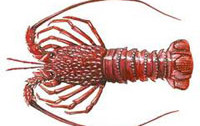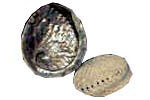
(especially the Rock Lobster: Jasus lellandi)
Lobsters, like shrimps and crabs, are decapods – literally meaning 10 legs – and can be found in all of the world’s tropical and sub-tropical seas as well as more temperate waters. They are predatory, nocturnal animals with a vividly decorated coat. They are often numerous locally; they linger in crevices (with their long antennae sticking out) during the day and hunt small benthic organisms at night, but they also feed on organic detritus whenever they happen across it. As with all crustaceans, the lobster moults or sheds its shell to grow.
Up until the end of the 19th century lobster was so plentiful that it was often used as fish bait. Sadly, with lobster’s ever-increasing popularity those days are now gone forever. Lobsters have recently suffered a dramatic demographic decline; intensive fishing has annihilated entire populations, especially where tourism abounds. The lobster families that you may encounter are the spiny rock lobsters, Palinuridae, the slipper lobsters, Scyllaridae and the true reef lobsters, Nephropidae. The true reef lobsters, Nephropidae, with their enlarged pincers on the first pair of legs, tend to prefer warmer waters, and are unlikely to be seen in these waters. The first pair of walking legs carries large but slightly unequal pincers that can be both formidable and dangerous.
The Palinurus genus (frequently transcribed as Panulirus) is represented by numerous species in all of the world’s tropical and sub-tropical seas as well as more temperate waters. It is a predatory, nocturnal animal with a vividly decorated coat. South Africa’s commercial rock lobster fishery is based on two species, the south coast lobster Palinurus gilchristi and the west coast lobster Jasus lalandii.
The south coast lobster tends to be found in deeper waters, around 100m. The west coast lobster is an inshore species that is caught commercially by traps and hoopnets deployed from small vessels, and is also harvested by recreational divers. It occurs predominantly along the Atlantic seaboard, where the waters are cooled by the Benguela Current, but is also occasionally found on the Cape south coast to as far north as East London. In the East London area, the west coast lobster distribution gives way to that of the inshore east coast lobster (Panuulirus homarus), a species which prefers warmer waters We would particularly like information on west coast lobster, but please record sightings of all lobster species, if possible.
Because of the popularity of rock lobsters, west coast lobsters, which are generally more abundant than their east coast relatives, support an important commercial fishery. Over the last decade, annual harvests have varied between 2000 and 4000 tonnes, but in the 1950s catches were as high as 10 000 tonnes per year. These large volumes have steadily eroded the supply of animals of legal size. West and east coast rock lobsters have very different biological characteristics. The West coast lobster grows more slowly, moults only once each year, taking approximately 6-9 years to reach the legal size limit of 80mm carapace length. East coast lobsters are much faster growing, reaching their minimum legal size of 57mm carapace length after just 3 years. Unsurprisingly, low numbers are indicative of overfishing.








Social Profiles